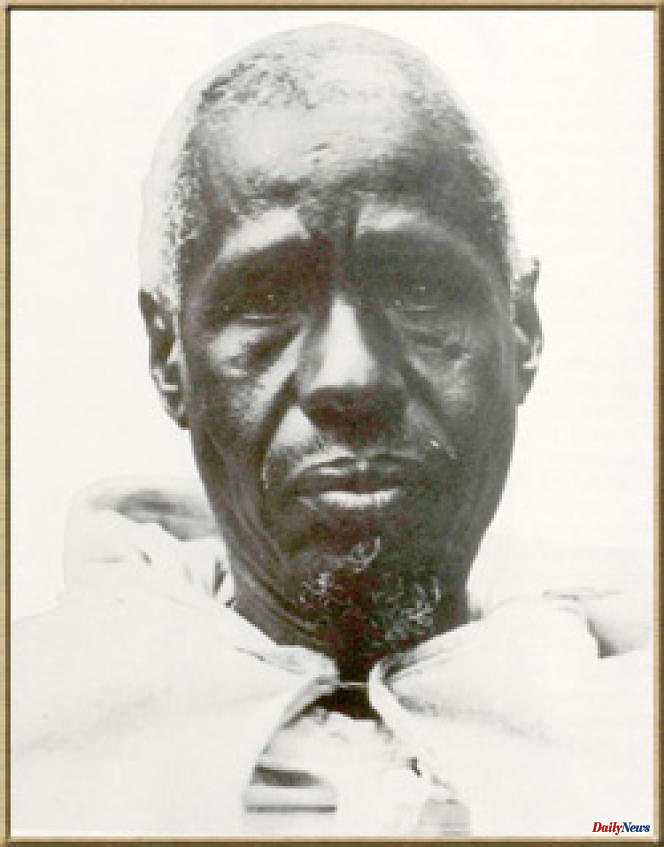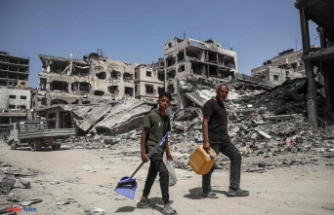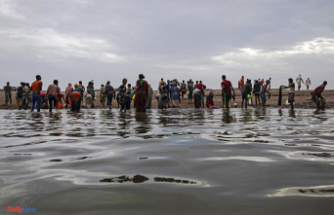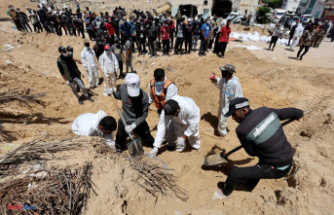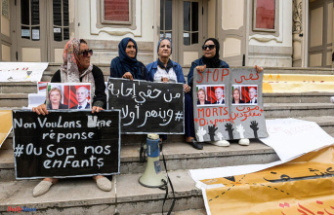Abdou Traoré carefully puts away his white high-top sneakers before kneeling down facing the grave. The freezing rain that sweeps the Auvergne cemetery on this January day does not disturb the 30-year-old, bundled up in a down jacket. He recites his rosary, chants, gets up. This ritual, the Burkinabe worker solemnly repeats every weekend. "It's a chance to live in Montluçon," he rejoices, plunging his hands into his faded jeans: "People come from afar to pray here. Yesterday a group of Africans even arrived from Canada…”
The sub-prefecture of Allier owes its astonishing notoriety among distant visitors to Cheikh Hamahoullah, a Sufi cleric born in Mali around 1883 and died in deportation in 1943. Since then, his remains rest in the eastern cemetery, on the heights from the city. The place has become the scene of an incessant and discreet pilgrimage for its millions of disciples scattered across the countries of the Sahel and the diasporas in America and Europe. In small groups, the faithful come to seek the intercession of the man they consider to be a holy man and a martyr mowed down by colonial brutality.
Born to a learned Mauritanian father and a Malian Fulani aristocrat, Cheikh Hamahoullah (also spelled "Hamallah") has long been a thorn in the side of the French authorities. His fate changed at the age of 19 when the Algerian sheikh Sidi Mohammed Lakhdar, representative of the Tidjaniyya brotherhood, a Sufi congregation, appointed him as his successor. The beginning of the 20th century marked the rise of the great marabouts in North Africa and West Africa. These scholars, versed in the learning and exegesis of the Koran, embody religious and moral authority among the Muslim faithful. They enjoy considerable popular aura and cult following. Within their schools, the "zawiyas", they preach, teach, guide.
An "agitator" who worries
Sheikh Hamahoullah emerges in a Sahel destabilized by the new colonial order. In Nioro, a town located in present-day Mali and future stronghold of the religious, the French regime imposed its law by taxing, as elsewhere in its possessions, cattle, the main source of wealth for populations impoverished by recurrent food shortages. In this tense social context, Sheikh Hamahoullah, from a lineage descending from the Prophet Muhammad, saw his reputation grow. The Nioro guide joins forces with scholars and influential families in the region, like Tierno Bokar, the spiritual master of the writer Amadou Hampâté Bâ, who will devote a novel to him, Life and Teaching of Tierno Bokar, which has become a classic. of literature.
"Hamallism", as the French power calls it, is spreading far from its cradle to extend from Mauritania to Côte d'Ivoire. To the point of arousing the concern of colonial governors, who described the monk as "agitator" and "dangerous marabout" in official correspondence, while trying to make him an ally. "When the French authorities tried to approach him with a view to taking advantage of his prestige and the veneration he enjoyed among the crowds, he made them understand that it was neither lawful nor possible for him, as a sheikh speaking in name of Islam, to endorse colonization," writes historian Alioune Traoré, who draws on colonial archives and has devoted a thesis to religion (Cheikh Hamahoullah, man of faith and resistant, ed. L 'Harmattan, 2015).
While some marabouts make do with the power in place, Sheikh Hamahoullah refuses decorations and official invitations, according to diplomatic sources cited by Alioune Traoré. In his zawiya of Nioro, he even decrees the shortening of a central liturgical prayer for the Tidjanes, in order, he says, to return to the original practice. This gesture provoked deep dissent within the brotherhood and ended up annoying the colonial authorities, who interpreted it as a form of moral resistance towards them – a reading fueled by certain marabouts dissatisfied with the growing success of the Sharif of Nioro.
The insubordination of the sheikh ends up being sanctioned. From 1925, the religious guide underwent successive exiles, first in Mederdra (Mauritania), where he was interned for five years, before being transferred to Côte d'Ivoire and Algeria. He returned to Nioro almost ten years after his first exile, in 1936. Before being arrested again in 1941 and deported to France following bloody unrest between different community factions in Mauritania, linked to his brotherhood.
Locked up by the Vichy regime
Very cultured (2.5 tons of books and manuscripts will be seized by the colonial authorities during his arrest), Cheikh Hamahoullah spent his last months of life locked up in an administrative internment establishment in Ardèche. This structure inherited from the Third Republic imprisoned nearly 600,000 political dissidents between 1939 and 1946, according to military historian Vincent Giraudier. The sheriff of Nioro is detained in various hotels and castles requisitioned in Vals-les-Bains (Ardèche), where other personalities hated by the Vichy regime meet, such as Vincent Auriol, Georges Mandel or Paul Reynaud.
Far from his land, Sheikh Hamahoullah is wasting away. He spends his days in prayer, eating mainly fruit, according to testimonies collected by Zidane Meriboute, research fellow at the University of London (School of Oriental and African Studies), from the son of the director of the establishment. of internment. "For a man who had the whole Sahel behind him, the isolation - he spoke six languages, but not French - was difficult to live with. Without forgetting that he suffered terribly from the Ardèche cold, to the point that his transfer to Corsica was considered by the colonial authorities. But it will not take place”, reports the researcher, author of Islamism, Sufism, Evangelism: war or peace (ed. Labor and Fides, 2010).
In the fall of 1942, the health of the dignitary declined sharply. He was hospitalized in Montluçon, where his death from heart disease was recorded on January 16, 1943. In the city occupied by the Germans, Sheikh Hamahoullah was hastily buried in the common ground reserved for the destitute. For fear of the reactions of faithful Hamallists in the Sahel, the colonial authorities kept his disappearance secret until the Liberation. The information revealed, West African ambassadors and politicians flock to the East Cemetery. Malian Prime Minister Younoussi Touré went there in 1992.
Among his disciples is Tiécoura Diawara, a teacher from Abidjan. In 1956, discovering that the burial of the religious leader was in danger of being raised, he bought a concession below the cemetery and had his body moved, facing Mecca. According to some historians, the future Ivorian President Félix Houphouët-Boigny, then President René Coty's Minister of Health, would have financed the embellishment of the tomb after having meditated there.
A place of pilgrimage
Since 2010, the body of the sheikh rests in a perpetual concession offered by the grandson of Tiécoura Diawara. Covered with white gravel, the 2.40 m by 1 m burial has become a place of pilgrimage. The question of the repatriation of the remains arose for a time, but it remains unresolved to this day. “During an official interview with Charles de Gaulle in 1964, Mauritanian President Moktar Ould Daddah made the request. But local leaders in Tichitt, the sheikh's hometown, warned him because some of his followers do not believe in his death. The return of his remains could have caused serious unrest,” explains Zidane Meriboute.
Roland Ferragu holds part of the Montluçonnaise history of Cheikh Hamahoullah. At the head of the funeral services of the town hall from 1970 to 2014, this amateur historian has seen “nearly a thousand visitors” pass each year. “They were writing to me from all over West Africa to arrange their visit. They arrived moved and dubious. Once in front of the grave, I was always asked the same question: "Are you sure it's really him?" So I was like, "Yeah, that's not a myth." “Explains the retiree, inexhaustible on the history of African Muslim brotherhoods.
The crowds are such that the municipality has printed an explanatory note on the life of the sheikh to give it to the pilgrims, always a little flabbergasted in this nine-hectare cemetery. Despite these singular waves of pilgrimage, the history remains little known to the people of Montluçon.
While his movement was harshly repressed during colonization – two of his sons were shot after his arrest, supporters were sentenced to death – Sheikh Hamahoullah gave birth to a powerful spiritual current. "Its appearance was the major phenomenon in Sahelian Islam at the beginning of the 20th century," says historian Alioune Traoré. In Mali, his son Bouyé Haïdara, at the head of the zawiya of Nioro, embodies a leading religious authority, with prodigious political influence. Maker of kings, he remains a voice listened to and feared by the powerful.

